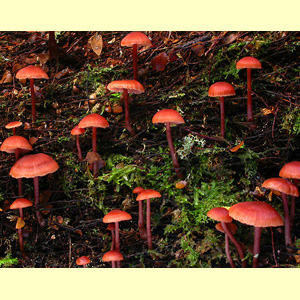
images/Laccaria/Laccaria_canaliculata_TM_DSCN7169.jpg
Small to medium, rarely large, agarics, usually growing on the ground, or occasionally on litter, wood, vertebrate animal carcasses or dung, common after fire. The spore print is white, but in contrast the usually thickish lamellae are pale pink to brick-red. Pileus pink, or orange- to reddish brown, not viscid, usually translucent-striate, always hygrophanous. Lamellae adnexed, adnate, sinuate or notched, subdecurrent or decurrent. Stipe central or rarely excentric. Partial veil remnants absent. Several species have two-spored basidia. Spores hyaline, non-amyloid, spinose (can be smooth in extra-Australian species); germ pore absent. Cheilocysitida present or absent, and then not obvious, but can be highly branched at the apex. Lamellar trama regular. Pileipellis a cutis. Clamp connections present.
Hygrocybe also has thick lamellae, but the spores are almost always smooth. In addition, the fruit-body is often brightly coloured red or yellow and the pileus can be viscid. In the only species of
Hygrocybe that can have spinose spores (
H. anomala) the pileus is sometimes viscid, the spore outline is often uneven or medially constricted and the spines are not evenly distributed over the spore. Some species of
Tubaria have a similarly coloured and translucent-striate pileus to
Laccaria, but the lamellae are thinner and more crowded, with a serrate margin, and the spore print is brown. Species of
Lepista,
Clitopilus morphogroup Rhodocybe and
Entoloma differ in the pinkish brown spore print and the spores that are not spinose.
Laccaria Berk. & Broome, Ann. Mag. Nat. Hist., ser. 5, 12: 370 (1883).
Eleven species: eight native, including the four-spored
Laccaria canaliculata (brick-red lamellae) and
Laccaria sp. B (flesh-pink lamellae), and the two-spored
L. lateritia (often called
L. fraterna), and three exotic:
L. laccata (under oak),
L. proxima (under pine) and
L. tortilis (under willow and birch). Most old records are erroneously as
L. laccata. Additional to the species keyed out by May (1997) are two species only found under
Nothofagus,
L. masoniae (rather pale brown pileus and long thin stipe) and
Laccaria sp. A (very large).
Sequestrate (truffle-like) relatives are currently placed in Hydnangium and Podohydnangium.
W.A., S.A., Qld, N.S.W., Vic. and Tas. (and probably also N.T.).
Widespread in native forests (including cool-temperate rainforest, with Nothofagus, but also drier forests), and also in plantations and gardens with native or exotic trees. Common after fire.
On the ground, rarely on wood or tree ferns. Occasionally associated with vertebrate animal remains.
Ectomycorrhizal.
Bougher, N.L. (2009a),
Fungi of the Perth region and beyond: a self-managed field book, Western Australian Naturalists' Club (Inc.), Perth. [
Description and
Illustration of
L. lateritia and
L. proxima]
Bougher, N.L. & Syme, K. (1998), Fungi of Southern Australia. University of Western Australia Press, Nedlands. [Description, Illustration and Microcharacters of L. lateritia]
Brundrett, M., Bougher, N., Dell, B., Grove, T. & Malajczuk, N. (1996), Working with Mycorrhizas in Forestry and Agriculture. ACIAR Monograph 32. Australian Centre for International Agricultural Research, Canberra. [Illustration of L. lateritia (as L. fraterna), and Laccaria sp.]
Fuhrer, B. (2005), A Field Guide to Australian Fungi. Bloomings Books, Hawthorn. [Description and Illustration of L. canaliculata, L. lateritia, L. masoniae, L. proxima and Laccaria sp. A (as Laccaria sp., p. 103)]
Fuhrer, B. & Robinson, R. (1992), Rainforest Fungi of Tasmania and South-east Australia. CSIRO Press, East Melbourne. [Illustration of L. canaliculata and L. masoniae]
May, T.W. (1997), Laccaria, in C.A.Grgurinovic, Larger Fungi of South Australia, 296–310. The Botanic Gardens of Adelaide and State Herbarium and The Flora and Fauna of South Australia Handbooks Committee, Adelaide. [Descriptions and Microcharacters of L. canaliculata, L. laccata, L. lateritia, L. proxima, L. tortilis and Laccaria spp. B, C, D and E, and Illustration of L. canaliculata, L. lateritia, L. proxima and Laccaria spp. B, D and E, along with Key to nine of the Australian species]
McCann, I.R. (2003), Australian Fungi Illustrated. Macdown Productions, Vermont. [Illustration of L. proxima and several unnamed species]
Young, A.M. (2005b), A Field Guide to the Fungi of Australia. University of New South Wales Press, Sydney. [Description and B&W Illustration of L. lateritia]

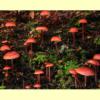

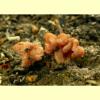
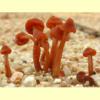
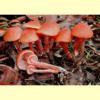
_AK_28_sml.jpg)
